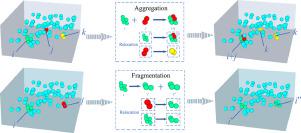Water Research ( IF 11.4 ) Pub Date : 2021-02-22 , DOI: 10.1016/j.watres.2021.116953 Xiaoteng Shen , Mingze Lin , Yuliang Zhu , Ho Kyung Ha , Michael Fettweis , Tianfeng Hou , Erik A. Toorman , Jerome P.-Y. Maa , Jinfeng Zhang

|
The quasi-Monte Carlo (QMC) method was enhanced to solve the population balance model (PBM) including aggregation and fragmentation processes for simulating the temporal evolutions of characteristic sizes and floc size distributions (FSDs) of cohesive sediments. Ideal cases with analytical solutions were firstly adopted to validate this QMC model to illustrate selected pure aggregation, pure fragmentation, and combined aggregation and fragmentation systems. Two available laboratory data sets, one with suspended kaolinite and the other with a mixture of kaolinite and montmorillonite, were further used to monitor the FSDs of cohesive sediments in controlled shear conditions. The model results show reasonable agreements with both analytical solutions and laboratory experiments. Moreover, different QMC schemes were tested and compared with the standard Monte Carlo scheme and a Latin Hypercube Sampling scheme to optimize the model performance. It shows that all QMC schemes perform better in both accuracy and time consumption than standard Monte Carlo scheme. In particular, compared with other schemes, the QMC scheme using Halton sequence requires the least particle numbers in the simulated system to reach reasonable accuracy. In the sensitivity tests, we also show that the fractal dimension and the fragmentation distribution function have large impacts on the predicted FSDs. This study indicates a great advance in employing QMC schemes to solve PBM for simulating the flocculation of cohesive sediments.
中文翻译:

基于准蒙特卡罗的絮凝模型,用于水环境中的细颗粒粘性沉积物
增强了准蒙特卡罗(QMC)方法,以解决包括聚集和破碎过程在内的人口平衡模型(PBM),以模拟粘性沉积物的特征尺寸和絮体尺寸分布(FSD)的时间演变。首先采用具有解析解的理想情况来验证此QMC模型,以说明所选的纯聚集,纯碎片以及组合的聚集和碎片系统。两种可用的实验室数据集,一种是悬浮高岭石,另一种是高岭石和蒙脱石的混合物,被用于在受控剪切条件下监测粘性沉积物的FSD。模型结果与分析解决方案和实验室实验均显示出合理的一致性。而且,测试了不同的QMC方案,并将其与标准的Monte Carlo方案和Latin Hypercube Sampling方案进行比较,以优化模型性能。它表明,所有QMC方案在准确性和时间消耗上均比标准Monte Carlo方案表现更好。特别是,与其他方案相比,使用Halton序列的QMC方案在模拟系统中需要最少的粒子数才能达到合理的精度。在敏感性测试中,我们还表明,分形维数和碎片分布函数对预测的FSD有很大的影响。这项研究表明在采用QMC方案求解PBM以模拟粘性沉积物絮凝方面取得了重大进展。它表明,所有QMC方案在准确性和时间消耗上均比标准Monte Carlo方案表现更好。特别是,与其他方案相比,使用Halton序列的QMC方案在模拟系统中需要最少的粒子数才能达到合理的精度。在敏感性测试中,我们还表明,分形维数和碎片分布函数对预测的FSD有很大的影响。这项研究表明在采用QMC方案求解PBM以模拟粘性沉积物絮凝方面取得了重大进展。它表明,所有QMC方案在准确性和时间消耗上均比标准Monte Carlo方案表现更好。特别是,与其他方案相比,使用Halton序列的QMC方案在模拟系统中需要最少的粒子数才能达到合理的精度。在敏感性测试中,我们还表明,分形维数和碎片分布函数对预测的FSD有很大的影响。这项研究表明在采用QMC方案求解PBM以模拟粘性沉积物絮凝方面取得了重大进展。我们还表明,分形维数和碎片分布函数对预测的FSD有很大的影响。这项研究表明在采用QMC方案求解PBM以模拟粘性沉积物絮凝方面取得了重大进展。我们还表明,分形维数和碎片分布函数对预测的FSD有很大的影响。这项研究表明在采用QMC方案求解PBM以模拟粘性沉积物絮凝方面取得了重大进展。









































 京公网安备 11010802027423号
京公网安备 11010802027423号